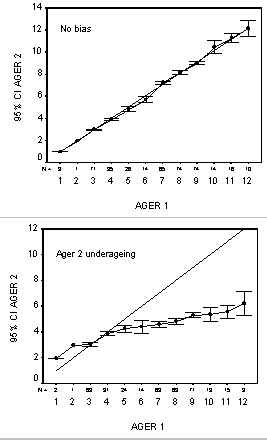Quality Control in Ageing
The scientific and stock assessment literature contains more incorrect age data than many people recognize. In some cases, the ageing errors are present, but do not influence the conclusions. In other cases, the errors are large, rendering the conclusions meaningless. The major source of these errors is quality control, or more correctly, lack of quality control.
Quality control (QC) is normally equated with age validation, which is often difficult and expensive to undertake. However, validation is only one of the three components of QC, and in some cases, is the smallest source of error. All ageing studies which involve more than one set of ages, whether at the daily or yearly level, should incorporate a complete QC program containing the following:
- age validation - demonstration that the age based on counts of periodic growth increments is, on average, equal to the true age of the fish
- tests for bias and long-term drift - demonstration that the age reader interprets the growth increments in the same way (on average) as other age readers and at other times
- measures of precision - measures of repeatability among age readers or within the same age reader on different occasions
Age validation is generally accepted to be a validation of an ageing methodology rather than the ageing accuracy of an individual age reader. Therefore, it is most often applied to demonstrate that, for example, otolith sections along an axis parallel to the sulcus produce accurate ages. Current methods for the validation of fish age are described in the section Age Validation.
Validated or not, different age readers can easily interpret a given otolith in different ways. If the difference is consistent - that is, one reader is higher or lower than the other for one or more age groups, at least on average - there is a bias. A bias may also occur within a reader over a period of time, such that a given age reader interprets an otolith differently now than was the case a few years ago. Long-term drift such as this is not unusual, and can be both dangerous and difficult to detect. Standard measures of precision such as CV, APE and percent agreement do NOT detect such a bias, particularly if it occurs only in old fish. Nor can replicate readings of a sample taken from the current year detect long-term drift. However, an age bias plot is well suited to detecting bias, and should be a standard component of any ageing program.
Measures of precision are meaningless if bias is present. However, if bias is absent, the coefficient of variation (CV) and average percent error (APE) are both useful measures. Percent agreement has been widely used in the past, but is no longer used by most laboratories. The reason? Percent agreement is very sensitive to the age range in the sample: two age readers will always have higher percent agreement on a sample of young fish than on a sample of older fish. By contrast, both CV and APE are relatively insensitive to the age range. Many laboratories now require their age readers to age a subsample of a reference collection of otoliths for each stock or species on a periodic basis (eg- annually). Age bias plots and CV's are based on this comparison to ensure that long-term quality is being maintained. Ideally, age validation will have first been carried out on the reference collection, although this is not always possible. A more detailed description of age bias plots and other statistical methods for detecting bias, as well as equations for CV and APE, are presented in Campana et al. (1995) and Campana (2001).
